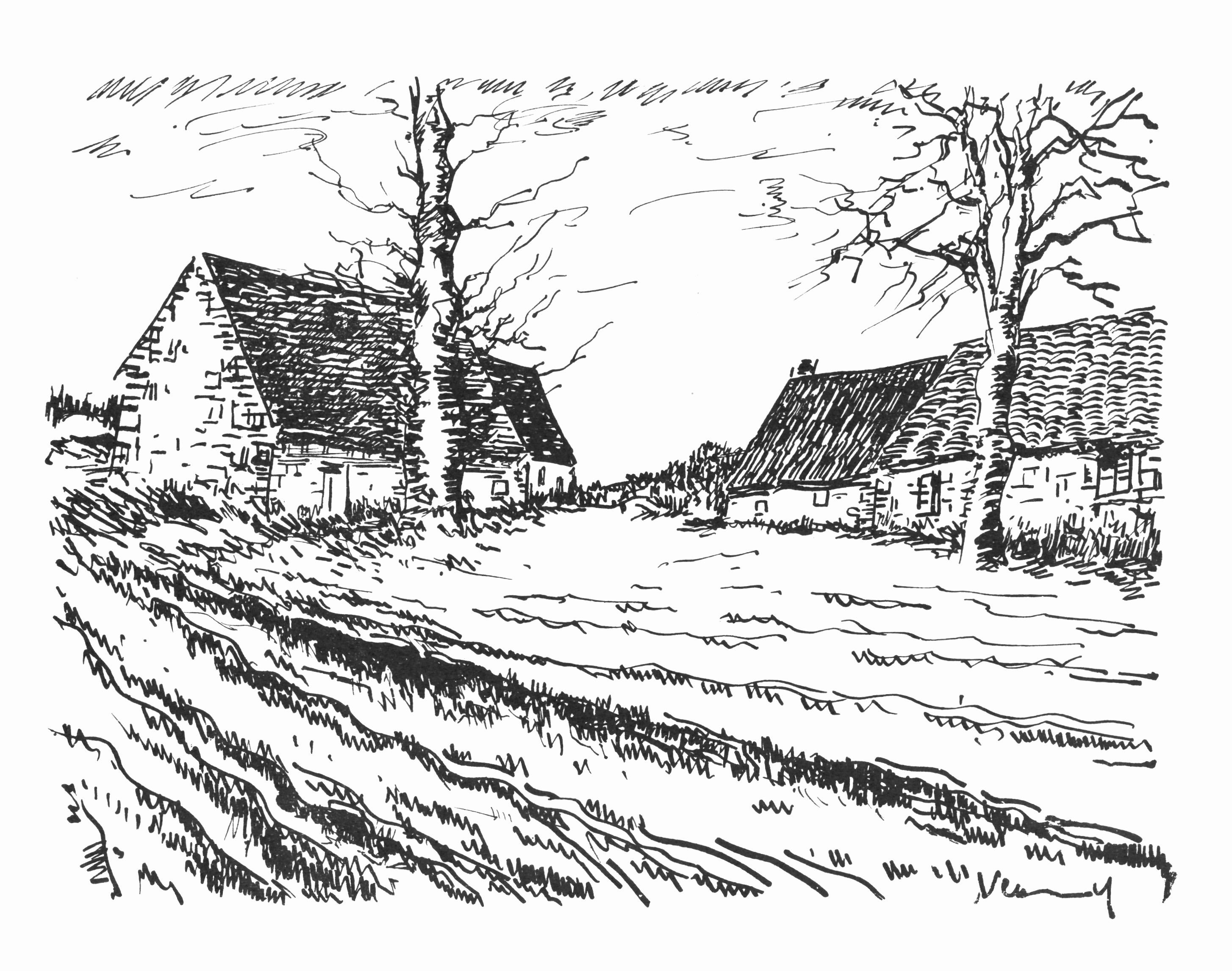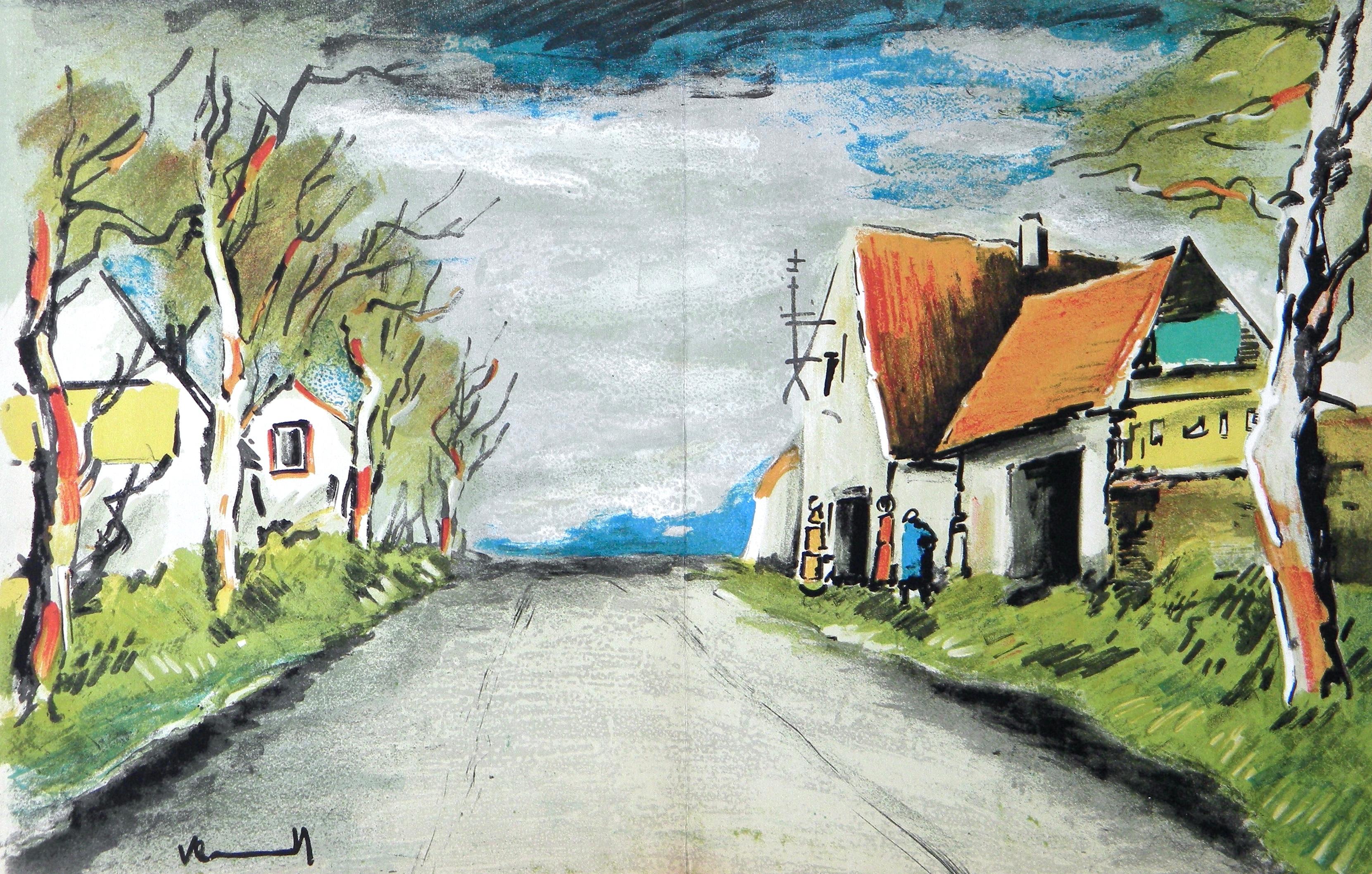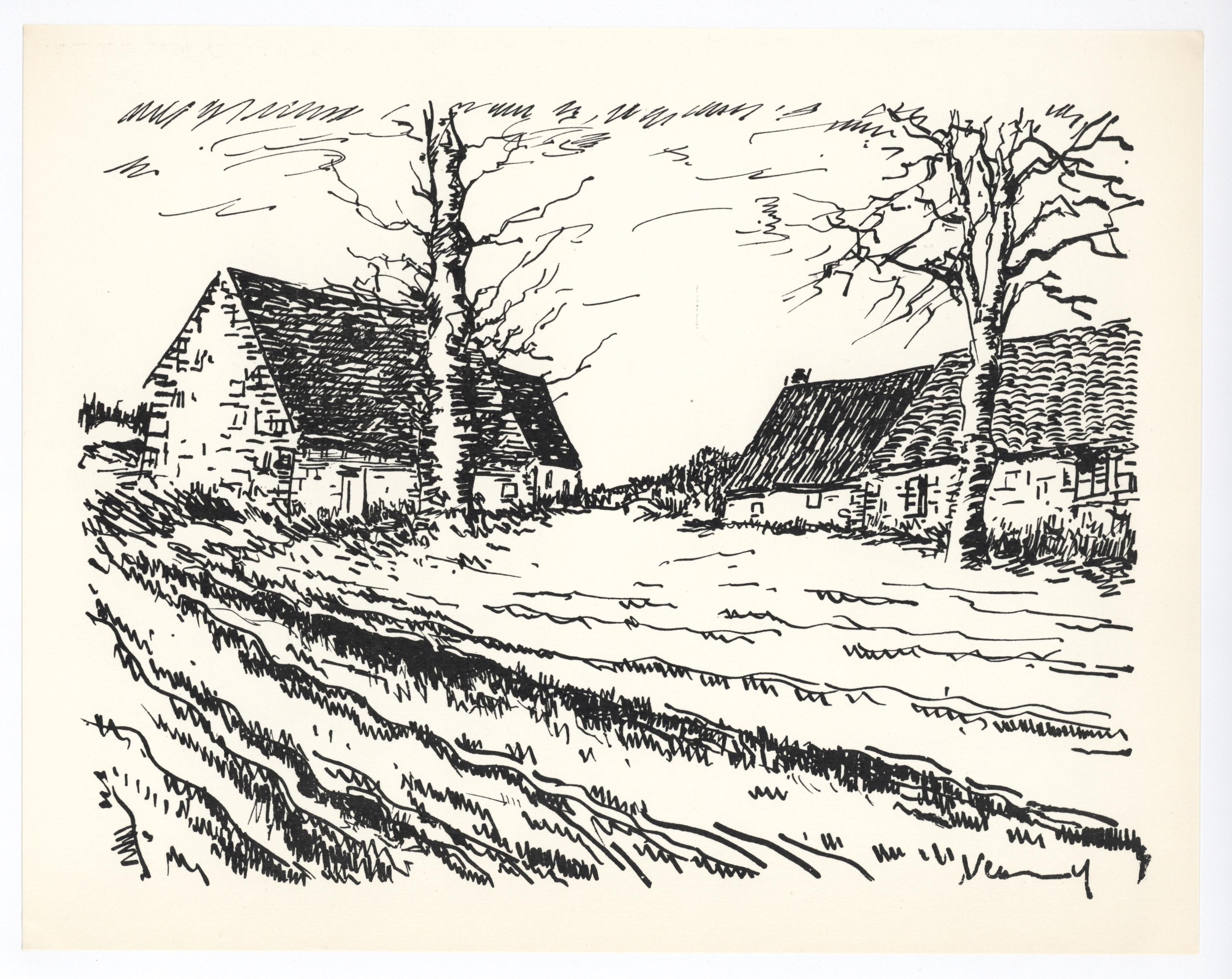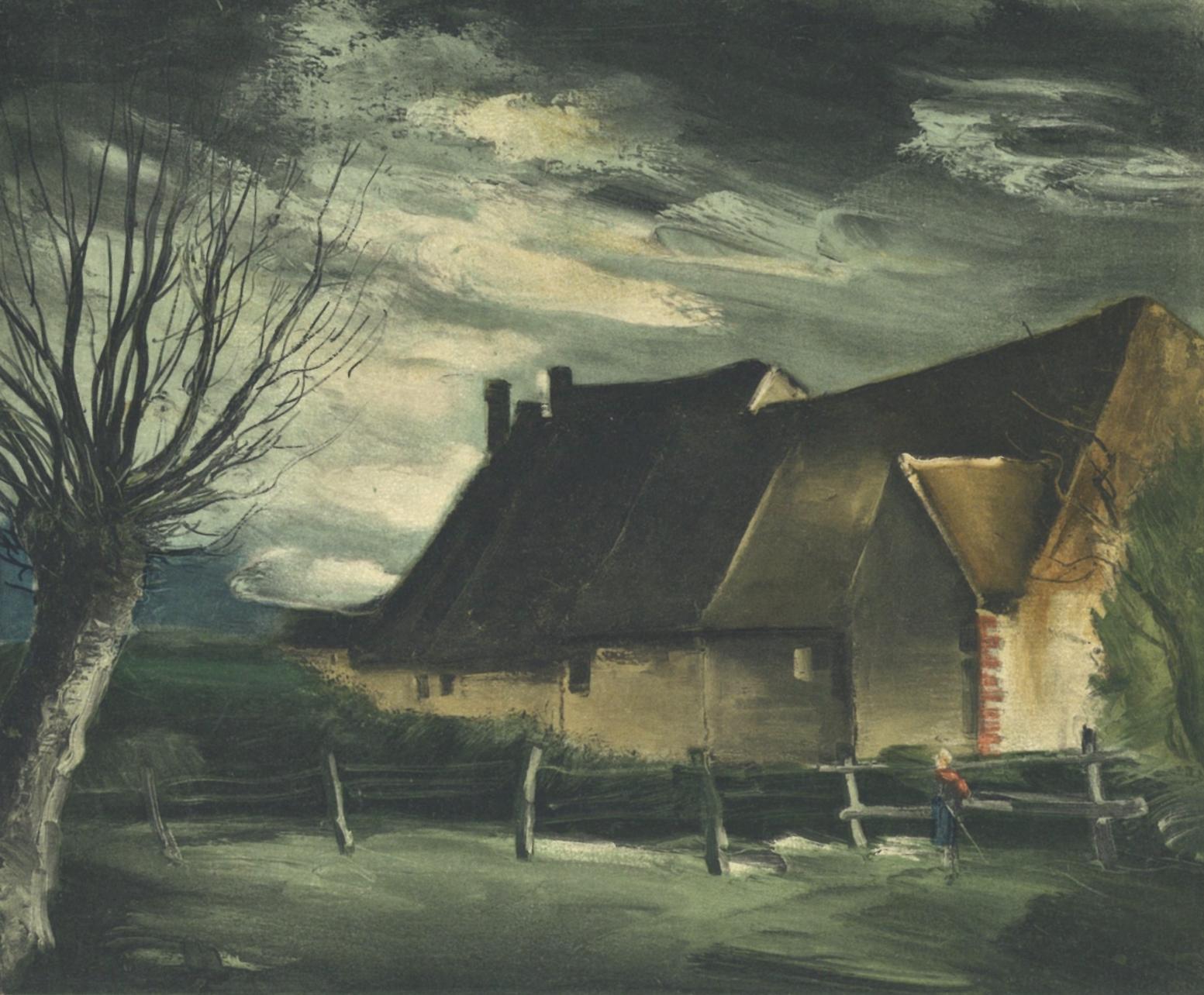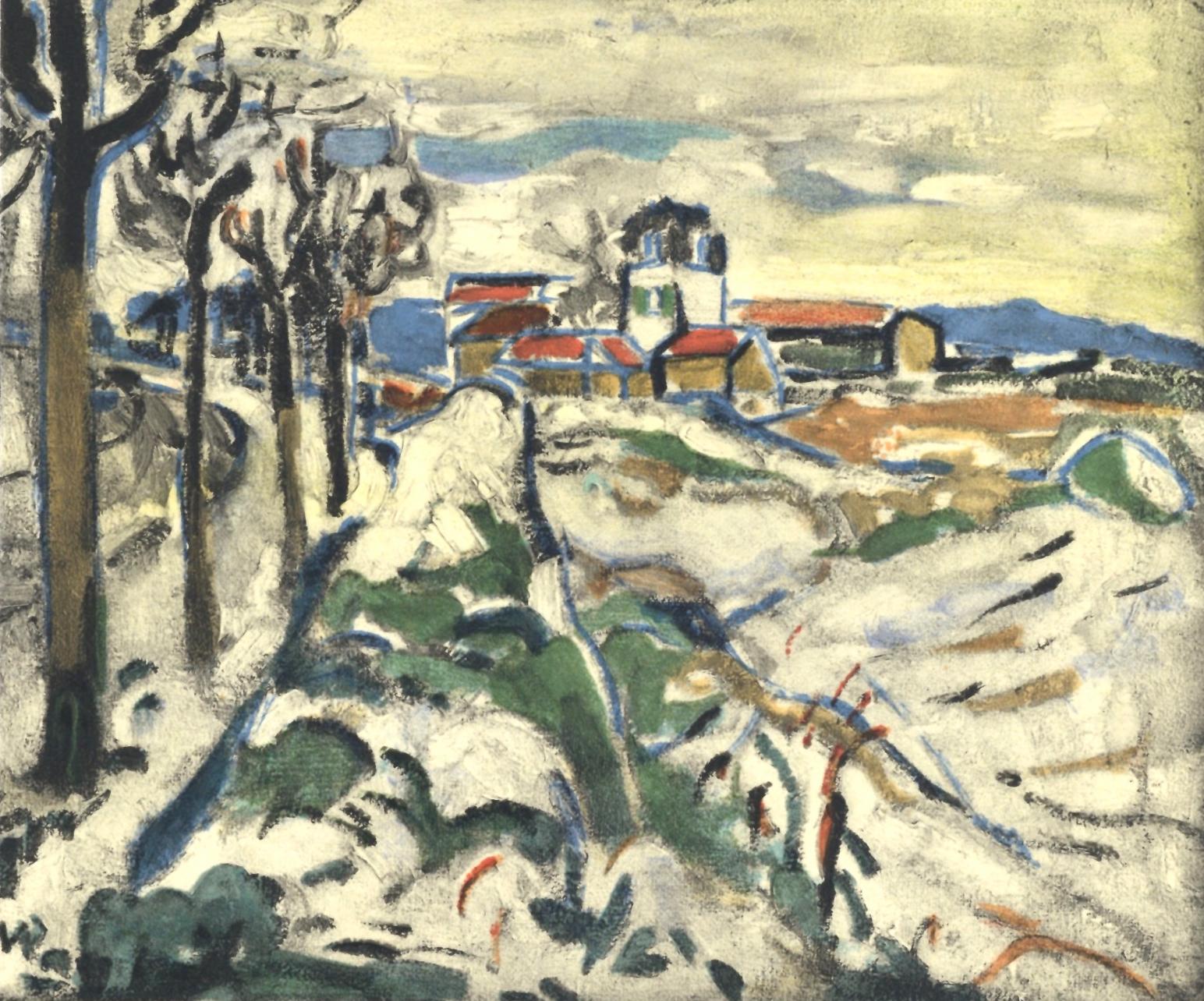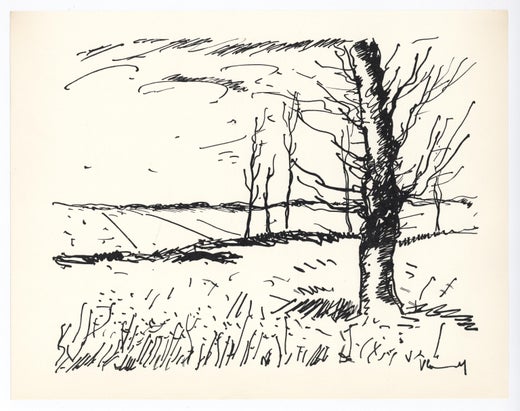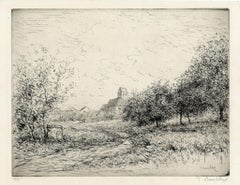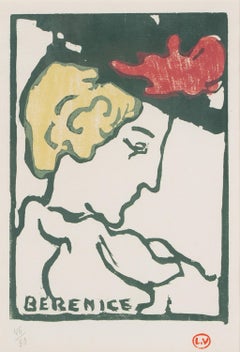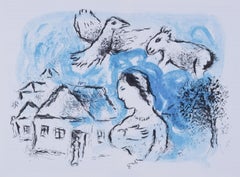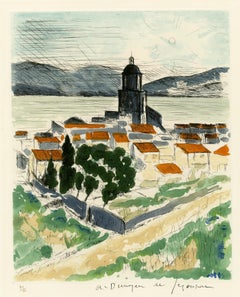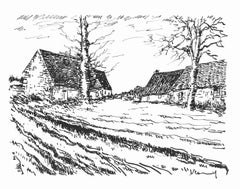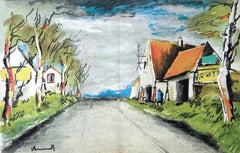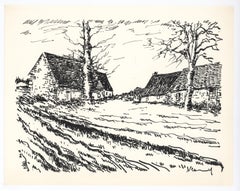Items Similar to Bougival
Want more images or videos?
Request additional images or videos from the seller
1 of 12
Maurice de VlaminckBougival1914
1914
$5,500
£4,282.01
€4,869.35
CA$7,907.44
A$8,683.90
CHF 4,534.89
MX$103,645.93
NOK 57,452.77
SEK 53,548.24
DKK 36,367.67
About the Item
Bougival
Woodcut, 1914
Signed and numbered in pencil
Edition 30, this numberd 22
Printed on laid Van Gelder Zonen paper
Published by Henri Kanweiler, Paris
Printed by Paul Birault, Paris
Bougival is located west of Paris, on the left bank of the River Seine.
This woodcut was inspired by Vlaminck's 1905 Fauvist masterpiece of the same title in the collection of the Detroit Institute of Art.
An impression of this image is in the Yale Univeristy Art Gallery,
Condition: Very slight sun staining, otherrwise very good
Image/block size: 13 1/4 x 16 1/4 inches
Sheet size: 19 1/8 x 22 1/8 inches
Reference: Walterskirchen 11b
Maurice de Vlaminck (4 April 1876 – 11 October 1958) was a French painter. Along with André Derain and Henri Matisse, he is considered one of the principal figures in the Fauve movement, a group of modern artists who from 1904 to 1908 were united in their use of intense colour.] Vlaminck was one of the Fauves at the controversial Salon d'Automne exhibition of 1905.
Life
Maurice de Vlaminck was born on Rue Pierre Lescot in Paris. His father Edmond Julien was Flemish and taught violin and his mother Joséphine Caroline Grillet came from Lorraine and taught piano His father taught him to play the violin.[3] He began painting in his late teens. In 1893, he studied with a painter named Henri Rigalon on the Île de Chatou In 1894 he married Suzanne Berly. The turning point in his life was a chance meeting on the train to Paris towards the end of his stint in the army. Vlaminck, then 23 and already active in anarchist circles in Paris, met an aspiring artist, André Derain, with whom he struck up a lifelong friendship.] When Vlaminck completed his army service in 1900, the two rented a studio together, the Maison Levanneur, which now houses the Cneai,[6] for a year before Derain left to do his own military service. In 1902 and 1903 he wrote several mildly pornographic novels illustrated by Derain. He painted during the day and earned his livelihood by giving violin lessons and performing with musical bands at night.
Vlaminck participated in the controversial 1905 Salon d'Automne exhibition. After viewing the boldly colored canvases of Vlaminck, Henri Matisse, André Derain, Albert Marquet, Kees van Dongen, Charles Camoin, and Jean Puy, the art critic Louis Vauxcelles disparaged the painters as "fauves" (wild beasts), thus giving their movement the name by which it became known, Fauvism.
In 1911, Vlaminck traveled to London and painted by the Thames. In 1913, he painted again with Derain in Marseille and Martigues. In World War I he was stationed in Paris, and began writing poetry. Eventually he settled in Rueil-la-Gadelière, a small village south-west of Paris. He married his second wife, Berthe Combes, with whom he had two daughters. From 1925 he traveled throughout France, but continued to paint primarily along the Seine, near Paris. Resentful that Fauvism had been overtaken by Cubism as an art movement Vlaminck blamed Picasso "for dragging French painting into a wretched dead end and state of confusion". During the Second World War, Vlaminck visited Germany and on his return published a tirade against Picasso and Cubism in the periodical Comoedia in June 1942. Vlaminck wrote many autobiographies.
Vlaminck died in Rueil-la-Gadelière on 11 October 1958.
Artistic career
Two of Vlaminck's groundbreaking paintings, Sur le zinc (At the Bar) and L'homme a la pipe (Man Smoking a Pipe) were painted in 1900.
For the next few years Vlaminck lived in or near Chatou (the inspiration for his painting houses at Chatou), painting and exhibiting alongside Derain, Matisse, and other Fauvist painters. At this time his exuberant paint application and vibrant use of colour displayed the influence of Vincent van Gogh. Sur le zinc called to mind the work of Toulouse-Lautrec and his portrayals of prostitutes and solitary drinkers, but does not attempt to probe the sitter's psychology—a break with the century-old European tradition of individualized portraiture. According to art critic Souren Melikian, it is "the impersonal cartoon of a type. In his landscape paintings, his approach was similar. He ignored the details, with the landscape becoming a vehicle through which he could express mood through violent colour and brushwork. An example is Sous bois, painted in 1904. The following year, he began to experiment with "deconstruction," turning the physical world into dabs and streaks of colour that convey a sense of motion. His paintings Le Pont de Chatou (The Chatou Bridge), Les Ramasseurs de pommes de terre (The Potato Pickers), La Seine a Chatou (The River Seine at Chatou) and Le Verger (The Orchard) exemplify this trend.
Artistic influences
Vlaminck's compositions show familiarity with the Impressionists, several of whom had painted in the same area in the 1870s and 1880s. After visiting a Van Gogh exhibit, he declared that he "loved Van Gogh that day more than my own father". From 1908 his palette grew more monochromatic, and the predominant influence was that of Cézanne.[7] His later work displayed a dark palette, punctuated by heavy strokes of contrasting white paint.
Some of his works are held at the Minneapolis Institute of Art.
Courtesy Wikipedia
- Creator:Maurice de Vlaminck (1876-1958, French)
- Creation Year:1914
- Dimensions:Height: 13.25 in (33.66 cm)Width: 16.25 in (41.28 cm)
- Medium:
- Movement & Style:
- Period:
- Condition:
- Gallery Location:Fairlawn, OH
- Reference Number:Seller: FA107851stDibs: LU14015736832
Maurice de Vlaminck
Maurice de Vlaminck was a French painter, best known as one of the spearheads of the Fauvism movement at the start of the 20th century. His reputation rests predominantly on his landscapes, though he also produced still lifes and portraits. Born in Paris in 1876, Vlaminck had relatively little artistic training and, as a young man, dreamt of becoming a professional cyclist. A chance encounter in 1900, however, when he was nearing the end of his national service in the army, proved fateful. It was with the budding artist, André Derain, whom he met when a train they were aboard derailed. The pair lived in the small town of Chatou, a few miles along the River Seine from Paris, and they chose to complete their homeward journey from the French capital that day on foot. They struck up a friendship, and before long were sharing a studio. Derain and Vlaminck would become, alongside Henri Matisse, the driving forces behind Fauvism, the first avant-garde art movement of the 20th century. Partly inspired by the recent innovations of Paul Gauguin and Vincent van Gogh, it was characterised by aggressive brushwork, simplified forms and intense non-naturalistic colours. Its name came from the reaction of a critic in 1905 who compared the artists to fauves (‘wild beasts’). Vlaminck enjoyed painting in primary colours, and is particularly associated with scenes set in and around Chatou. Standout examples include Restaurant de la Machine à Bougival (1905) (today found in the Musée d'Orsay) and The Seine at Chatou (1906) (found in the Metropolitan Museum of Art in New York). The poet Guillaume Apollinaire hailed Vlaminck as ‘the wildest of the Fauves’. In the years immediately before the outbreak of World War I, the artist’s style shifted. His palette grew slightly more sombre, and there was a greater emphasis on solidity and a landscape's underlying structure. This revealed the influence of Paul Cezanne — the subject of a ground-breaking, posthumous retrospective in Paris in 1907. Vlaminck worked in a munitions factory during the war. His paintings after it were much darker and more realistic than those with which he had made his name. He died in 1958, aged 82.
About the Seller
5.0
Recognized Seller
These prestigious sellers are industry leaders and represent the highest echelon for item quality and design.
Gold Seller
Premium sellers maintaining a 4.3+ rating and 24-hour response times
Established in 1978
1stDibs seller since 2013
827 sales on 1stDibs
Typical response time: <1 hour
Associations
International Fine Print Dealers Association
- ShippingRetrieving quote...Shipping from: Akron, OH
- Return Policy
More From This Seller
View AllLe chemin de l'eglise
By Jacques Beurdeley
Located in Fairlawn, OH
Signed and numbered in pencil; Signed in the plate
Edition: 75
Provenance:
Frederick Keppel & Co. Inc. No. L 8621 (label)
References And Exhibitions:
Published by Edmund Sagot, ...
Category
1920s Landscape Prints
Materials
Etching
Berenice
By Louis Valtat
Located in Fairlawn, OH
Berenice
Color woodcut, 1900-1910
Signed with the artist's red ink stamp (see photo)
Edition: 50 (46/50)
Signed with the artist's red ink initials stamp, Lugt 1771, Sup.
Condition: E...
Category
Early 1900s French School Portrait Prints
Materials
Woodcut
Le Village (The village)
By Marc Chagall
Located in Fairlawn, OH
Le Village (The village)
Original lithograph in colors, listed in the artist's catalog raisonne of his prints, 1977
From: Derriere le Miroir, No. 225,
Edition 15,000 as published in...
Category
1970s French School Figurative Prints
Materials
Lithograph
Saint Tropez
By André Dunoyer de Segonzac
Located in Fairlawn, OH
Saint Tropez
Etching with aquatint, printed in colors, 1964
Signed in ink and numbered in pencil
Edition: 71/100
Issued for the album St. Tropez et la Provence, in 1966
Reference: Lo...
Category
1960s Post-Impressionist Landscape Prints
Materials
Etching
Brittany Landscape with Figure
By Louis Oscar Griffith
Located in Fairlawn, OH
Brittany Landscape with Figure
Etching & color aquatint, c. 1920
Signed lower right (see photo)
Numbered lower left: "No. 21" (see photo)
An early color etching by the artist, based ...
Category
1920s American Impressionist Landscape Prints
Materials
Aquatint
Automne
By Georges Rouault
Located in Fairlawn, OH
Automne (Autumn)
Crayon and brush and tusche lithograph with scraping, 1927
Signed, titled, and annotated in brown ink (see photos)
Condition: Good
Signature and inscrption faded to brown
Image size: 17 x 22 1/4 inches
Sheet size: 21 5/8 x 28 1/2 inches
This is the second of three version of this image (a aquatint/heliogravure (1927, this lithograph (1933) and a color aquatint (1938).
Reference:
Francois Chapon and Isabelle Rouault, Rouault Oeuvre Grave (Monte Carlo: Editions Andre Sauret, 1978), 364 viii/VIII, third edition of 175 printed in 1933.
There is also a etching/heliogravure as well as a color aquatint version of this image. It is considered to by an important image in Rouault's work and recognized as a famous print...
Category
1920s French School Prints and Multiples
Materials
Lithograph
You May Also Like
Paysage
By Maurice de Vlaminck
Located in San Francisco, CA
Artist: Maurice de Vlaminck (French, 1876-1958)
Title: Paysage
Year: 1952
Medium: Original color lithograph
Edition: Numbered 66/75 in pencil
Paper: Arches
Image size: 14.5 x ...
Category
Mid-20th Century Fauvist Landscape Prints
Materials
Lithograph
Maurice de Vlaminck, The Challonges, from Vlaminck, 1958
By Maurice de Vlaminck
Located in Southampton, NY
This exquisite lithograph by Maurice de Vlaminck (1876–1958), titled Les Challonges (The Challonges), from the album Vlaminck, originates from the 1958 edition published by Andre Sau...
Category
1950s Fauvist Landscape Prints
Materials
Lithograph
$716 Sale Price
20% Off
Free Shipping
Maurice de Vlaminck, The Road, from Vlaminck, 1958
By Maurice de Vlaminck
Located in Southampton, NY
This exquisite lithograph by Maurice de Vlaminck (1876–1958), titled La route (The Road), from the album Vlaminck, originates from the 1958 edition published by Andre Sauret, Editeur...
Category
1950s Fauvist Landscape Prints
Materials
Lithograph
$716 Sale Price
20% Off
Free Shipping
"Les Challonges" original lithograph
By Maurice de Vlaminck
Located in Henderson, NV
Medium: original lithograph. Printed in Paris in 1958 at the Mourlot atelier, and published by Andre Sauret in an edition of 2000. Size: 9 1/2 x 12 1/4 inches (242 x 310 mm). Signed ...
Category
1950s Landscape Prints
Materials
Lithograph
Maurice de Vlaminck, The High Madness, from Vlaminck, 1958 (after)
By Maurice de Vlaminck
Located in Southampton, NY
This exquisite lithograph after Maurice de Vlaminck (1876–1958), titled La Haute Folie (The High Madness), from the album Vlaminck, originates from the 1958 edition published by Andr...
Category
1950s Fauvist Landscape Prints
Materials
Lithograph
$716 Sale Price
20% Off
Free Shipping
Maurice de Vlaminck, The Hills of Chatou, from Vlaminck, 1958 (after)
By Maurice de Vlaminck
Located in Southampton, NY
This exquisite lithograph after Maurice de Vlaminck (1876–1958), titled Les Coteaux de Chatou (The Hills of Chatou), from the album Vlaminck, originates from the 1958 edition publish...
Category
1950s Fauvist Landscape Prints
Materials
Lithograph
$716 Sale Price
20% Off
Free Shipping
